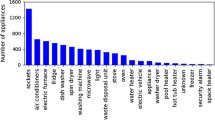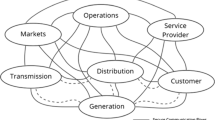Abstract
The energy system is undergoing a major transformation with the global emphasis on decarbonization. Distributed generation is projected to play a significant role in the new energy system, and energy models are informing how distributed generation can be integrated reliably and economically. In this work, we present an end-to-end computational framework for distributed energy resource (DER) modeling, REopt Lite™, which captures the interface of technology, economics, and policy in the energy modeling process. We describe the problem space, the building blocks of the model, the scaling capabilities of the design, the optimization formulation, and the extensibility of the model. We present a framework for accelerating the techno-economic analysis of behind-the-meter distributed energy resources to enable rapid planning and decision-making, thereby enabling greater renewable energy deployment. This computation framework is open-sourced to facilitate transparency, flexibility, and wider collaboration opportunities within the worldwide energy modeling community.








Similar content being viewed by others
Notes
Note that the described limitations are combined from all the tools, they may or may not be present in every single referenced tool.
SAM being a notable exception, which has been open-sourced.
Open-sourced under BSD-3 License, which is permissive with minimal restriction on use and distribution.
Diesel generator is restricted to resilience applications only in the webtool; grid-connected use of diesel generators is allowed in the API.
Theoretically unlimited, but in the code implementation a big number (10e + 7) is used.
Information on state net metering limits is available at https://www.dsireusa.org/.
References
Abgottspon, H., Andersson, G.: Approach of integrating ancillary services into a medium-term hydro optimization. In: XII SEPOPE: Symposium of Specialists in Electric Operational and Expansion Planning. Rio de Janiero (2012)
Becker, W., Cutler, D., Anderson, K., Olis, D.: REopt: enabling renewable energy, storage, and combined heat & power. In: Proceedings of the ACEEE 2019 summer study on energy efficiency in industry. Portland, OR (2019)
Blair, N., DiOrio, N., Freeman, J., Gilman, P., Janzou, S., Neises, T., Wagner, M.: System Advisor Model (SAM) General Description. National Renewable Energy Laboratory, Golden, CO. Retrieved 2019, from https://www.nrel.gov/docs/fy18osti/70414.pdf (2018). Accessed 7 Dec 2019
Bowman, M.: EIA projects that renewables will provide nearly half of world electricity by 2050. U.S. Energy Information Administration. Retrieved 12 7, 2019, from https://www.eia.gov/todayinenergy/detail.php?id=41533 (2019). Accessed 7 Dec 2019
Coffrin, C., Hijazi, H., Van Hentenryck, P.: Network flow and copper plate relaxations for AC transmission systems. In: Power Systems Computation Conference, pp. 1–8. IEEE, Piscataway (2016)
Connolly, D., Lund, H., Mathiesen, B., Leahy, M.: A review of computer tools for analysing the integration of renewable energy into various energy systems. Appl. Energy 87(4), 1059–1082 (2010). https://doi.org/10.1016/j.apenergy.2009.09.026
Cuesta, M., Castillo-Calzadilla, T., Borges, C.: A critical analysis on hybrid renewable energy modeling tools: an emerging opportunity to include social indicators to optimise systems in small communities. Renew. Sustain. Energy Rev. (2020). https://doi.org/10.1016/j.rser.2019.109691
Cutler, D., Olis, D., Elgqvist, E., Li, X., Laws, N., Diorio, N., Anderson, K.: REopt: A Platform for Energy System Integration and Optimization. National Renewable Energy Laboratory, Golden (2017)
Deru, M., Field, K., Studer, D., Benne, K., Griffith, B., Torcellini, P., Crawley, D.: US Department of Energy Commercial Reference Building Models of the National Building Stock. NREL, Golden (2011)
Dobos, A.P.: PVWatts Version 5 Manual. Golden, CO: National Renewable Energy Laboratory. Retrieved 04 10, 2020, from https://pvwatts.nrel.gov/downloads/pvwattsv5.pdf (2014). Accessed 10 Apr 2020
Draxl, C., Clifon, A., Hodge, B.-M., McCaa, J.: The Wind Integration National Dataset (WIND) Toolkit. Appl. Energy 151, 355–366 (2015). https://doi.org/10.1016/j.apenergy.2015.03.121
Dunning, I., Huchette, J., Lubin, M.: JuMP: a modeling language for mathematical optimization. Soc. Ind. Appl. Math. Rev. 59, 295–320 (2017). https://doi.org/10.1137/15M1020575
EIA: EIA projects nearly 50% increase in world energy usage by 2050, led by growth in Asia. eia.gov. Retrieved 06 18, 2020, from https://www.eia.gov/todayinenergy/detail.php?id=41433 (2019). Accessed 18 June 2020
Energy, D.O.: Commercial Reference Buildings. (Office of Energy Efficiency & Renewable Energy) Retrieved 04 15, 2020, from https://www.energy.gov/eere/buildings/commercial-reference-buildings (n.d.). Accessed 15 Apr 2020
EPA: Fuel and Carbon Dioxide Emissions Savings Calculation Methodology for Combined Heat and Power Systems. U.S. Environmental Protection Agency Combined Heat And Power Partnership. Retrieved from https://www.epa.gov/sites/production/files/2015-07/documents/fuel_and_carbon_dioxide_emissions_savings_calculation_methodology_for_combined_heat_and_power_systems.pdf (2015)
EPA: AVoided Emissions and geneRation Tool (AVERT). U.S. Environmental Protection Agency Office of Air and Radiation Climate Protection Partnerships Division. Retrieved from https://www.epa.gov/sites/production/files/2019-05/documents/avert_user_manual_05-20-19_508.pdf (2019). Accessed 15 Apr 2020
EPRI: Storage Value Estimation Tool (StorageVET). Retrieved 2019, from https://storagevet.com/ (2016). Accessed 7 Dec 2020
Fathima, A.H., Palanisamy, K.: Optimization in microgrids with hybrid energy systems—a review. Renew. Sustain. Energy Rev. 45, 431–446 (2015). https://doi.org/10.1016/j.rser.2015.01.059
Geli: Analyze and Design. Retrieved from https://geli.net/geli-platform/analyze-and-design/ (2018). Accessed 11 Nov 2018
Henbest, S.: Energy to 2040—Faster Shift to Clean, Dynamic, Distributed. BloombergNEF. Retrieved 12 7, 2019, from https://about.bnef.com/blog/henbest-energy-2040-faster-shift-clean-dynamic-distributed/ (2017). Accessed 7 Dec 2019
Hirst, E., Brendan, K.: Electric-Power Ancilary Services. Oak Ridge National Laboratory, Oak Ridge (1996)
Krah, K.: Behind-the-Meter Solar + Storage Modeling Tool Comparison. In: 47th Annual National Solar Conference and Summit. Boudler, CO. Retrieved from https://www.osti.gov/biblio/1507688-behind-meter-solar-storage-modeling-tool-comparison (2019). Accessed 7 Dec 2019
Lambert, T., Gilman, P., Lillenthal, P.: Micropower system modeling with HOMER. Integr. Altern. Sources Energy 1(1), 379–385 (2006)
Luna-Rubio, R., Trejo-Perea, M., Vargas-Vázquez, D., Rios-Moreno, G.: Optimal sizing of renewable hybrids energy systems: a review of methodologies. Sol. Energy 86(4), 1077–1088 (2012). https://doi.org/10.1016/j.solener.2011.10.016
Marcy, C.: Today in Energy. U.S. Energy Information Administration. Retrieved 12 05, 2019, from https://www.eia.gov/todayinenergy/detail.php?id=38752 (2019)
Mishra, S., Anderson, K.: Probabilistic resilience of DER systems—a simulation assisted optimization approach. IEEE PES ISGT NA. IEEE. Retrieved from https://arxiv.org/ftp/arxiv/papers/2008/2008.05455.pdf (2021)
Narimani, M.R., Asghari, B., Sharma, R.: Optimal sizing and operation of energy storage for demand charge management and PV utilization. In: 2018 IEEE/PES Transmission and Distribution Conference and Exposition (T&D). Denver, CO, USA. (2018). https://doi.org/10.1109/TDC.2018.8440302
Neukomm, M., Nubbe, V., Fares, R.: Grid-interactive Efficient Buildings. Energy Efficiency & Renewable Energy. U.S. Department of Energy. Retrieved from https://www.energy.gov/sites/prod/files/2019/04/f61/bto-geb_overview-4.15.19.pdf (2019). Accessed 7 Dec 2019
Nguyen, T.A., Byrne, R.H.: Maximizing the cost-savings for time-of-use and net-metering customers using behind-the-meter energy storage systems. In: 2017 North American Power Symposium (NAPS). Morgantown, WV, USA. https://doi.org/10.1109/NAPS.2017.8107380 (2017)
NREL: PVWatts Calculator. (National Renewable Energy Laboratory) Retrieved 04 10, 2020, from https://pvwatts.nrel.gov/ (2020). Accessed 10 Apr 2020
NREL: REopt Lite—Webtool User Manual. National Renewable Energy Laboratory. Retrieved 06 25, 2020, from https://reopt.nrel.gov/tool/REopt%20Lite%20Web%20Tool%20User%20Manual.pdf (n.d.). Accessed 25 June 2020
NREL: REopt Lite™ API (Version 1). Retrieved from https://developer.nrel.gov/docs/energy-optimization/reopt-v1/ (n.d.). Accessed 15 Apr 2020
Ogunmodede, O., Anderson, K., Cutler, D., Newman, A.: Optimizing design and dispatch of a renewable energy system. Appl. Energy 287, 116527 (2021)
OpenEI: U.S. Utility Rate Database. Retrieved 04 08, 2020, from https://openei.org/wiki/Utility_Rate_Database (2017). Accessed 8 Apr 2020
Petrovic, N., Strezoski, L., Dumnic, B.: Overview of software tools for integration and active management of high penetration of DERs in emerging distribution networks. In: IEEE EUROCON 2019-18th International Conference on Smart Technologies. Novi Sad, Serbia. (2019). https://doi.org/10.1109/EUROCON.2019.8861765
Rebours, Y.G., Kirschen, D.S., Trotignon, M., Rossignol, S.: A survey of frequency and voltage control ancillary services—Part II: economic features. IEEE Trans. Power Syst. 22(1), 358–366 (2007)
REopt-Lite-Case-Study-A: Case Study Part I. Retrieved from https://reopt.nrel.gov/tool/results/8ad0650b-99fb-4f51-9ca5-7b57034fd046 (web interface) or https://developer.nrel.gov/api/reopt/v1/job/270848c3-0379-4a53-ab47-c0197b5de077/results?api_key=DEMO_KEY (API) (2020). Accessed 15 Apr 2020
REopt-Lite-Case-Study-B: Case Study Part II. Retrieved from https://reopt.nrel.gov/tool/results/88aa7f10-3a49-4fd1-94e6-01fb3bb66e1e (web interface) or https://developer.nrel.gov/api/reopt/v1/job/f82782e2-0176-44a6-82a4-f3897cd74ffb/results?api_key=DEMO_KEY (API) (2020). Accessed 15 Apr 2020
Ringkjøb, H.-K., Haugan, P.M., Solbrekke, I.M.: A review of modelling tools for energy and electricity systems with large shares of variable renewables. Renew. Sustain. Energy Rev. 96, 440–459 (2018). https://doi.org/10.1016/j.rser.2018.08.002
Rockx, C., Tate, J.E., Rogers, E.S.: Hybrid planning tool for solar and battery systems in Ontario. In: 2018 IEEE International Conference on Smart Energy Grid Engineering (SEGE). Oshawa, ON, Canada. (2018). https://doi.org/10.1109/SEGE.2018.8499437
Scioletti, M., Newman, A., Goodman, J., Zolan, A., Leyffer, S.: Optimal design and dispatch of a system of diesel generators, photovoltaics and batteries for remote locations. Optim. Eng. 18(3), 755–792 (2017)
Stadler, M., Groissbock, M., Cardoso, G., Marnay, C.: Optimizing distributed energy resources and building retrofits with the strategic DER-CAModel. Berkley Lab, Microgrids at Berkley. Retrieved 2020, from https://www.osti.gov/servlets/purl/1163652 (2014). Accessed 15 Apr 2020
Trabish, H.: As 100% renewables goals proliferate, what role for utilities? Utility Dive. Retrieved 12 5, 2019, from https://www.utilitydive.com/news/as-100-renewables-goals-proliferate-what-role-for-utilities/551165/ (2019). Accessed 5 Dec 2019
Tudu, B., Mandal, K.K., Chakraborty, N.: Behind the meter optimization of grid connected PV system. In: 2018 International Conference on Computing, Power and Communication Technologies (GUCON). Greater Noida, Uttar Pradesh, India. (2018). https://doi.org/10.1109/GUCON.2018.8675000
Vatanparvar, K., Sharma, R.: Battery optimal approach to demand charge reduction in behind-the-meter energy management systems. In: 2018 IEEE Power & Energy Society General Meeting (PESGM). Portland, OR, USA. (2018). https://doi.org/10.1109/PESGM.2018.8586597
Vejdan, S., Kline, A., Totri, M., Grijalva, S., Simmons, R.: Behind-the-meter energy storage: economic assessment and system impacts in Georgia. In: 2019 North American Power Symposium (NAPS). Wichita, KS, USA. (2019). https://doi.org/10.1109/NAPS46351.2019.9000287
Wu, D., Kintner-Meyer, M., Yang, T., Balducci, P.: Economic analysis and optimal sizing for behind-the-meter battery storage. In: 2016 IEEE Power and Energy Society General Meeting (PESGM). Boston, MA, USA. (2016). https://doi.org/10.1109/PESGM.2016.7741210
Acknowledgements
This work was authored by the National Renewable Energy Laboratory, operated by Alliance for Sustainable Energy, LLC, for the U.S. Department of Energy (DOE) under Contract No. DE-AC36-08GO28308. Funding was provided by the U.S. Department of Energy Office of Energy Efficiency and Renewable Energy Federal Energy Management Program and the Advanced Manufacturing Office. The authors would like to thank Andy Walker, Linda Parkhill, Kathleen Krah, Andrew Jeffery, Nick Muerdter, Xiangkun Li, Rob Eger, and Nicholas DiOrio for help with building and maintaining the REopt Lite API; and Adam Warren for reviewing the manuscript. The authors would also like to thank Rachel Shepherd (Office of Energy Efficiency and Renewable Energy, DOE) and Bob Gemmer (Advanced Manufacturing Office, DOE) for funding this work. The views expressed in the article do not necessarily represent the views of the DOE or the U.S. Government. The U.S. Government retains and the publisher, by accepting the article for publication, acknowledges that the U.S. Government retains a nonexclusive, paid-up, irrevocable, worldwide license to publish or reproduce the published form of this work or allow others to do so, for U.S. Government purposes.
Author information
Authors and Affiliations
Corresponding author
Additional information
Publisher's Note
Springer Nature remains neutral with regard to jurisdictional claims in published maps and institutional affiliations.
Rights and permissions
About this article
Cite this article
Mishra, S., Pohl, J., Laws, N. et al. Computational framework for behind-the-meter DER techno-economic modeling and optimization: REopt Lite. Energy Syst 13, 509–537 (2022). https://doi.org/10.1007/s12667-021-00446-8
Received:
Accepted:
Published:
Issue Date:
DOI: https://doi.org/10.1007/s12667-021-00446-8




